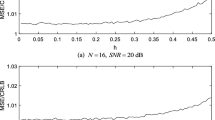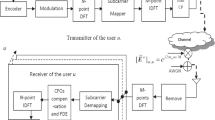Abstract
In this paper, a new data-aided joint timing and carrier frequency offset estimation algorithm in OFDM/OQAM system is proposed by utilizing identical central-symmetry ZC sequences before polyphase structure efficient implementation. Based on excellent auto-correlation performance of ZC sequence we derive a timing offset estimator with high accuracy and arbitrary capture range compared with two existed approaches. After the precision timing, a new frequency offset estimator is proposed by two parts, which considered both the identical and central-symmetry properties separately. Computer simulation indicates conspicuous performance improvement in timing offset and frequency offset estimation, especially in a AWGN channel which the proposed method possesses significant advantages while in multipath channel the new estimator can still reveal better performance when selecting the correct weighting factor.






Similar content being viewed by others
References
Siohan, P., Siclet, C., & Lacaille, N. (2002). Analysis and design of OFDM/OQAM systems based on filterbank theory. IEEE Transactions on Signal Processing, 50(5), 1170. doi:10.1109/78.995073.
Dandach, Y., & Siohan, P. (2010). In 2010 International conference on wireless communications and signal processing (WCSP) (pp. 1–5). doi:10.1109/WCSP.2010.5633459.
Fusco, T., Petrella, A., & Tanda, M. (2009). Data-aided symbol timing and CFO synchronization for filter bank multicarrier systems. IEEE Transactions on Wireless Communications, 8(5), 2705. doi:10.1109/TWC.2009.080860.
Bölcskei, H. (2001). Blind estimation of symbol timing and carrier frequency offset in wireless OFDM systems. IEEE Transactions on Communications, 49(6), 988.
Ciblat, P., & Serpedin, E. (2004). A fine blind frequency offset estimator for OFDM/OQAM systems. IEEE Transactions on Signal Processing, 52(1), 291.
Mattera, D., & Tanda, M. (2013). Blind symbol timing and CFO estimation for OFDM/OQAM systems. IEEE Transactions on Wireless Communications, 12(1), 268. doi:10.1109/TWC.2012.121112.120296.
Fusco, T., Petrella, A., & Tanda, M. (2008). In Proceedings of 16th European signal processing conference (EUSIPCO’08).
Fusco, T., Petrella, A., & Tanda, M. (2010). Joint symbol timing and CFO estimation for OFDM/OQAM systems in multipath channels. EURASIP Journal on Advances in Signal Processing, 2010(1), 897607. doi:10.1155/2010/897607 http://asp.eurasipjournals.com/content/2010/1/897607.
Saeedi-Sourck, H., & Sadri, S. (2013). Frequency-domain carrier frequency and symbol timing offsets estimation for offset QAM filter bank multicarrier systems in uplink of multiple access networks. Wireless Personal Communications, 70(2), 601. doi:10.1007/s11277-012-0710-7.
Katselis, B., & Rojas, R. (2013). A note on the SPICE method. Signal Processing, 93(9), 2777.
Dejin Kong, D. Q., Peng Gao, C. W., & Gao, J. (2013). In Wireless communications and networking conference( WCNC). IEEE Press: Shanghai, China.
Baltart, M., & Nossekj. (2013). In Proceedings of the 10th international symposium on wireless communication systems. VDE Press: Ilmenau, Germany.
Lélé, C. (2012). Iterative scattered-based channel estimation method for OFDM/OQAM[J]. EURASIP. Journal on Advances in Signal Processing, 2012(1), 1–14.
Cheng, G., Xiao, Y., Hu, S., & Li, S. (2013). Interference cancellation aided channel estimation for OFDM/OQAM system. Science China Information Sciences, 56(12), 1–8.
Baltar, N. (2013). Nossek, in vehicular technology conference (VTC fall). Las Vegas, NV: IEEE Press.
Kofidis, E., & Rontogiannis, A. (2013). In Proceedings of the 10th international symposium on wireless communication systems.VDE Press: Ilmenau, Germany.
Tonello, A. M., & Rossi, F. (2004). Proceedings of WPMC 2004, pp. 590–594.
Siohan, P., & Roche, C. (2000). Cosine-modulated filterbanks based on extended Gaussian functions. IEEE Transactions on Signal Processing, 48(11), 3052. doi:10.1109/78.875463.
Zhang, Z., Kayama, H., & Tellambura, C. (2009). New joint frame synchronisation and carrier frequency offset estimation method for OFDM systems. European Transactions on Telecommunications, 20(4), 413.
Park, B., Cheon, H., Kang, C., & Hong, D. (2003). A novel timing estimation method for OFDM systems. IEEE Communications Letters, 7(5), 239. doi:10.1109/LCOMM.2003.812181.
Zhang, Z., Liu, J., & Long, K. (2012). Low-complexity cell search with fast PSS identification in LTE. IEEE Transactions on Vehicular Technology, 61(4), 1719. doi:10.1109/TVT.2012.2188109.
Zhang, Z., Long, K., Zhao, M., & Liu, Y. (2005). Joint frame synchronization and frequency offset estimation in OFDM systems. IEEE Transactions on Broadcasting, 51(3), 389.
Acknowledgments
This research is supported by the Fundamental Research Funds for the Central Universities (No. FRF-TP-09-015A), and also supported by the National Natural Science Foundation of P.R.China (No.61272507).
Author information
Authors and Affiliations
Corresponding author
Appendix: Proof of Central-Symmetry in Eq. 17
Appendix: Proof of Central-Symmetry in Eq. 17
First, the prototype function \(g(kT_s)\) is discrete and real-symmetry with length \(\beta N\) and omit the \(T_s\) for simplification.
The nth polyphase decomposition of prototype function g(k) is given by Eq. 17
where \(l\in \{0,1,\ldots ,N-1\}\) and \(n\in \{0,1,\ldots ,\beta -1\}\). In order to prove the center-symmetry
Consider the difference value
and for every \(n\in \{0,1,\ldots ,\beta -1\}\), the corresponding \(\beta -1-n\in \{0,1,\ldots ,\beta -1\}\) satisfy a one-to-one correlation matching with n. Obviously, the answer to Eq. 38 is
That is the conclusion that the sum of all \(\beta\) parts of those polyphase decomposition meet the condition of central-symmetry.
Rights and permissions
About this article
Cite this article
Wang, J., Du, X., He, Z. et al. A Novel Data-Aided Joint Timing and Carrier Frequency Offset Estimation Based on Central Symmetry ZC Sequence in OFDM/OQAM Systems. Wireless Pers Commun 90, 1619–1634 (2016). https://doi.org/10.1007/s11277-016-3414-6
Published:
Issue Date:
DOI: https://doi.org/10.1007/s11277-016-3414-6




